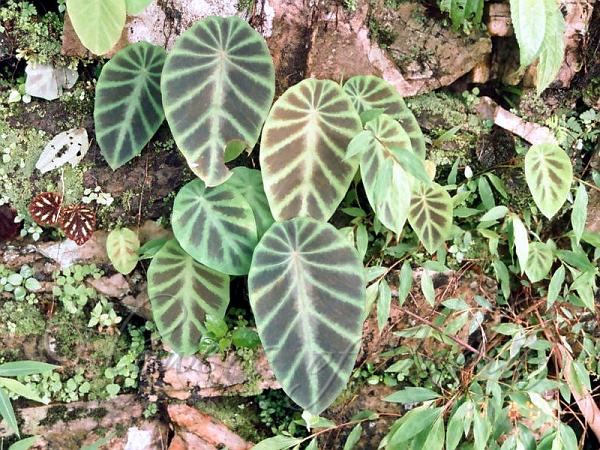|
| East-Himalayan Decorated Taro |
|

|

|
|
|
|
Photo: |
Botanical name: Colocasia affinis Family: Araceae (Arum family)
Synonyms: Colocasia bicolor, Colocasia affinis var. jenningsii, Alocasia jenningsii
Synonyms: Colocasia bicolor, Colocasia affinis var. jenningsii, Alocasia jenningsii
East-Himalayan Decorated Taro is a perennial herb with
decorative leaves. Leaves are 3-7; leaf-stalk light green or greenish
white, cylindric, 20-45 cm. Leaf blade pale green below, green or light
green above, with 4-6 pairs of large purple spots (lighter when growing
in a very shady environment), peltate, ovate-heart-shaped, 16-21 x
13-16 cm, membranous; primary lateral veins in 3 or 4 pairs, marginal
veins inprominent. Inflorescences are 1-3; flower-cluster-stalk pale
green, cylindric, much shorter than leaf-stalks, 6.4-15 cm. Spathe
constricted; tube convolute, green, almost cylindric, 1.3-2.7 x 0.6-1.8
cm; limb usually reflexed at anthesis, yellow, greenish white, or
yellowish, oblong-lanceshaped, 4.2-7.8 x 1.6-3.3 cm. Spadix is
stalkless, shorter than spathe. Young berries are green. East-Himalayan
Decorated Taro is found in moist shaded places in forests and at forest
margins, hillsides in limestone areas, at altitudes of 800-1400 m, in
East Himalaya, from Nepal to NE India, N Bangladesh, N Myanmar and
China.
Flowering: June-August.
| Identification credit: Pascal Bruggeman | Photographed enroute to Darjeeling, West Bengal. |
• Is this flower misidentified? If yes,